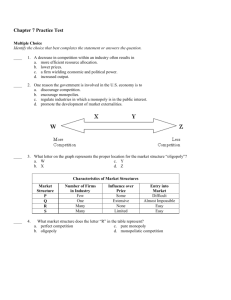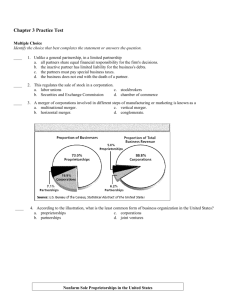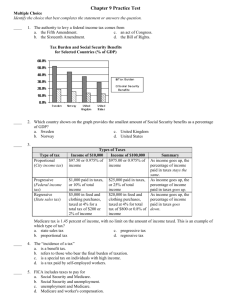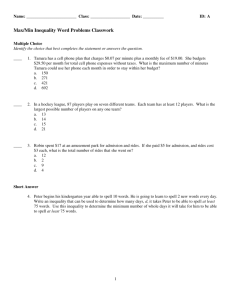World History Chapter 19: World War II Study Guide Mr
advertisement
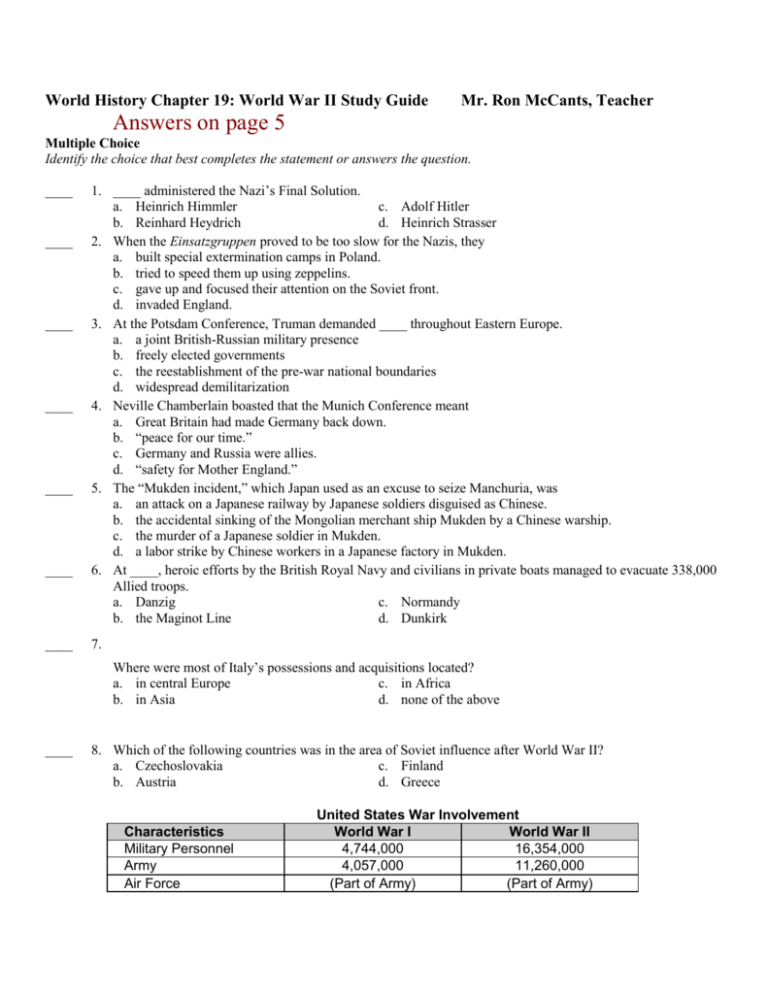
World History Chapter 19: World War II Study Guide Mr. Ron McCants, Teacher Answers on page 5 Multiple Choice Identify the choice that best completes the statement or answers the question. ____ ____ ____ ____ ____ ____ ____ 1. ____ administered the Nazi’s Final Solution. a. Heinrich Himmler c. Adolf Hitler b. Reinhard Heydrich d. Heinrich Strasser 2. When the Einsatzgruppen proved to be too slow for the Nazis, they a. built special extermination camps in Poland. b. tried to speed them up using zeppelins. c. gave up and focused their attention on the Soviet front. d. invaded England. 3. At the Potsdam Conference, Truman demanded ____ throughout Eastern Europe. a. a joint British-Russian military presence b. freely elected governments c. the reestablishment of the pre-war national boundaries d. widespread demilitarization 4. Neville Chamberlain boasted that the Munich Conference meant a. Great Britain had made Germany back down. b. “peace for our time.” c. Germany and Russia were allies. d. “safety for Mother England.” 5. The “Mukden incident,” which Japan used as an excuse to seize Manchuria, was a. an attack on a Japanese railway by Japanese soldiers disguised as Chinese. b. the accidental sinking of the Mongolian merchant ship Mukden by a Chinese warship. c. the murder of a Japanese soldier in Mukden. d. a labor strike by Chinese workers in a Japanese factory in Mukden. 6. At ____, heroic efforts by the British Royal Navy and civilians in private boats managed to evacuate 338,000 Allied troops. a. Danzig c. Normandy b. the Maginot Line d. Dunkirk 7. Where were most of Italy’s possessions and acquisitions located? a. in central Europe c. in Africa b. in Asia d. none of the above ____ 8. Which of the following countries was in the area of Soviet influence after World War II? a. Czechoslovakia c. Finland b. Austria d. Greece Characteristics Military Personnel Army Air Force United States War Involvement World War I World War II 4,744,000 16,354,000 4,057,000 11,260,000 (Part of Army) (Part of Army) Navy Marines Coast Guard Killed Wounded 599,000 4,183,000 79,000 669,000 9,000 241,000 116,516 405,399 204,002 670,846 Source: Historical Statistics of the United States. ____ 9. In terms of percentages, which of the following branches of the armed forces had the largest increase from World War I to World War II? a. Army c. Marines b. Navy d. Coast Guard ____ 10. I ask the fifty-two nations not to forget today the policy upon which they embarked eight months ago, and in faith of which I directed the resistance of my people against the aggressor whom they had denounced to the world. Despite the inferiority of my weapons, the complete lack of aircraft, artillery, munitions, hospital services, my confidence in the League was absolute. I thought it to be impossible that fifty-two nations, including the most powerful in the world, should be successfully opposed by a single aggressor. Counting on the faith due to treaties, I had made no preparation for war . . . . Haile Selassie, address to the League of Nations in Geneva, June 30, 1936 What is Haile Selassie asking the League of Nations to do? a. denounce the aggressor b. give Ethiopia weapons, aircraft, artillery, and munitions c. provide hospital services d. honor its treaties and come to the aid of Ethiopia Matching Match each item with the correct statement below. a. Axis Powers f. b. “Mukden incident” g. c. blitz h. d. Vichy France i. e. appeasement j. ____ ____ ____ ____ ____ ____ ____ ____ 11. 12. 13. 14. 15. 16. 17. 18. Einsatzgruppen Luftwaffe Munich Conference Yalta Conference Holocaust policy that sought peace and stability by satisfying the reasonable demands of dissatisfied powers Neville Chamberlain thought the agreement reached there meant “peace for our time” used as an excuse for Japanese seizure of Manchuria unoccupied France, governed by authoritarian regime under German control German air force Germany, Italy, and Japan special strike forces for carrying out Nazi Final Solution the slaughter of European civilians, particularly European Jews, by the Nazis Match each item with the correct statement below. a. isolationism f. Nazi-Soviet Nonaggression Pact b. Potsdam Conference g. Tehran Conference c. Anti-Comintern Pact d. D-Day e. Allied Powers ____ ____ ____ ____ ____ ____ ____ 19. 20. 21. 22. 23. 24. 25. h. blitzkrieg i. kamikaze j. Final Solution “lightning war” that utilized tanks supported by airplanes Great Britain, the Soviet Union, and the United States history’s greatest naval invasion Nazi plan for the extermination of the Jews Japanese pilots who flew suicide missions against U.S. warships meeting of the Big Three to discuss the final attack on Germany meeting at which Truman demanded free elections throughout Eastern Europe Short Answer Battle Deaths in World War II Country Battle Deaths USSR 7,500,000 Germany 3,500,000 Yugoslavia 410,000 Poland 320,000 Romania 300,000 United States 292,000 United Kingdom 245,000 France 210,000 Hungary 140,000 Finland 82,000 Italy 77,000 Greece 74,000 Canada 37,000 26. How did the number of Polish battle deaths compare with the number of German battle deaths during World War II? Why is the figure low? 27. In which country were most of the death camps located? 28. Why was it important to the Allies to destroy Japan’s merchant fleet? 29. The attackers had got in unimpeded because our fighters, which had engaged the preceding wave of torpedo planes only a few moments earlier, had not yet had time to regain altitude. Consequently, it may be said that the American dive-bombers’ success was made possible by the earlier martyrdom of their torpedo planes. Also, our carriers had no time to evade because clouds hid the enemy’s approach until he dived down to the attack. We had been caught flatfooted in the most vulnerable condition possible—decks loaded with planes armed and fueled for an attack. Mitsuo Fuchida, “Battle of Midway” What factors contributed to America’s victory in this battle? 30. Which country lost the most soldiers in World War I? Which country lost the most in World War II? How would these losses translate into actual numbers (approximately)? World History Chapter 19: World War II Study Guide Answer Section Mr. Ron McCants, Teacher MULTIPLE CHOICE 1. ANS: B PTS: 1 DIF: C REF: Pages 607-608 2. ANS: A PTS: 1 DIF: A REF: Pages 608-609 3. ANS: B PTS: 1 DIF: A REF: Page 618 4. ANS: B PTS: 1 DIF: A REF: Page 593 5. ANS: A PTS: 1 DIF: C REF: Page 594 6. ANS: D PTS: 1 DIF: A REF: Page 596 7. ANS: C PTS: 1 DIF: A REF: Page 593 8. ANS: A PTS: 1 DIF: A REF: Page 617 9. ANS: D PTS: 1 DIF: C REF: Pages 600-604 10. ANS: D PTS: 1 DIF: C REF: Pages 591-593 MATCHING 11. ANS: E PTS: 1 DIF: E REF: Page 592 12. ANS: H PTS: 1 DIF: A REF: Page 593 13. ANS: B PTS: 1 DIF: A REF: Page 594 14. ANS: D PTS: 1 DIF: E REF: Page 597 15. ANS: G PTS: 1 DIF: A REF: Page 597 16. ANS: A PTS: 1 DIF: A REF: Page 600 17. ANS: F PTS: 1 DIF: A REF: Pages 607-608 18. ANS: J PTS: 1 DIF: E REF: Pages 606-607 19. ANS: H PTS: 1 DIF: A REF: Page 596 20. ANS: E PTS: 1 DIF: E REF: Page 600 21. ANS: D PTS: 1 DIF: A REF: Page 603 22. ANS: J PTS: 1 DIF: E REF: Page 607 23. ANS: I PTS: 1 DIF: E REF: Page 614 24. ANS: G PTS: 1 DIF: A REF: Page 617 25. ANS: B PTS: 1 DIF: A REF: Page 618 SHORT ANSWER 26. ANS: Poland had less than a tenth as many battle deaths as Germany. The Poles were defeated very quickly. 27. ANS: Poland 28. ANS: If the Allies could isolate Japan, the country would not be able to get the resources needed to continue manufacturing war materiel or feed its population. 29. ANS: Japanese fighter planes had not recovered quickly enough from the first American assault; clouds hid the approach of the next wave of American planes; the Japanese shipdecks were loaded with fueled and armed planes. 30. ANS: Germany lost the most soldiers in World War I, and the Soviet Union lost the most in World War II. German losses accounted for 22.6% of the total World War I losses, while the Soviet losses accounted for 50% of the total World War II losses. The percentage of Soviet losses in World War II is more than twice the percentage of German losses in World War I. Germany lost a total of less than 2 million in World War I, while the Soviet Union lost a total of 7.5 million in World War II. Back to http://www.ChaplainRon.com/HighSchool




